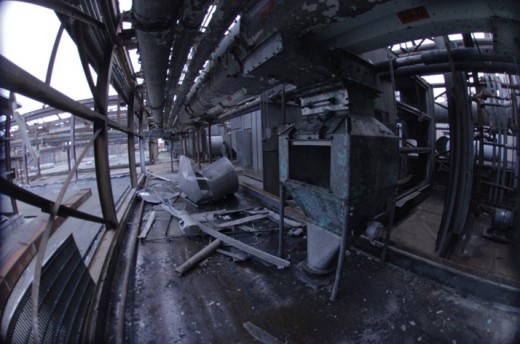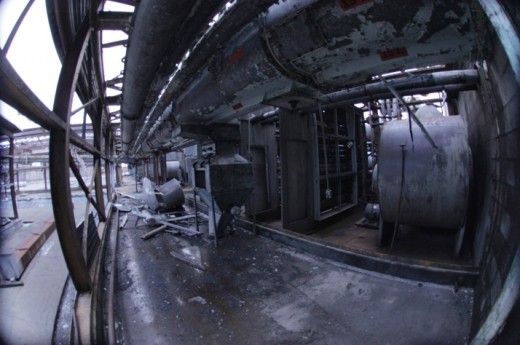
Two Trees is at it again.
An anonymous source alleges that lead paint is running rampant through our air and waterways for us to breathe and drink. The current demolition of Domino is occurring in our hyper-densely populated neighborhood with no regard to public health. The entire Domino site should be contained to protect public health by a method known as shrink wrap scaffolding which ensures that the job is done safely and properly. This should be done right away as the temperatures rise, so too will hazardous conditions.
Exposure to lead paint is very dangerous for many reasons. The inside of the entire “bin” structure is now completely exposed. As the latent chips on the heavy machinery and infrastructure are baking in the hot summer sun, they peel and flake away with the shifting winds coming off the East River. This process occurs as the binders in the paint, mostly contaminants break down over time making them become airborne. Aside from lead, other carcinogens such as benzene and methylene chloride are being blown in and around the East River corridor.
The developer needs to be more accountable for protecting the public health and growing concerns of the community. How can we protect ourselves from the hidden dangers posed by this new threat when simple steps are not being taken?

www.nyc.gov/html/doh/downloads/pdf/lead/lead03-a04.pdf
TRUE/FALSE QUESTIONS for THE COMMUNITY:
- House paint no longer contains lead, so it’s not a problem.
- False. Because household paint before the 1970’s often contained lead, it may still pose a problem. As lead paint ages, it can chip or crumble into dust. Exposure to lead paint dust or chips can cause serious health problems, especially to children and pregnant women. So, if you live in or own an older home, you need to know how to protect yourself and others.
- You can tell by looking if paint contains lead.
- False. The only way to be sure if paint contains lead is to have it tested by a qualified professional. Home test kits are not reliable, and can’t tell you whether the paint poses a risk.
- If I have lead-based paint, I can still safely remodel or renovate.
- True. Small projects that disturb old surfaces which have lead-based paint can be done safely. In fact, it is best to assume that building materials in an older home contain lead, and take proper precautions. Larger jobs should be done by trained professionals.
- Getting rid of lead paint is better than leaving it there.
- False. Lead paint that is in good condition is usually not a hazard. However, if you plan to do a project which disturbs the paint in any way, it must be done carefully.
- Some methods of removing lead-based paint actually do more harm than good.
- True. Some methods, such as dry sanding, dry scraping, torching, or power sanding can create huge amounts of lead dust. Once the dust is released into the home, it can make occupants sick if it enters the body. Always use a method that creates the least amount of dust and fumes.
- Preparing to do the job is as important as the methods used to do it.
- True. It’s important to take certain precautions to protect your family. Children and pregnant women should leave the work area. Remove all furnishings (even rugs, if possible) before beginning. The work area should be sealed with plastic and taped down to keep the lead dust in. Cover air vents and turn off heaters and air conditioning systems during renovation and remodeling.
- A dust mask will protect you from breathing lead dust.
- False. A dust mask is not sufficient. It is best to wear a properly fitted respirator with special lead (HEPA) filters. Coveralls, goggles and gloves are also important to wear–throw them away when the work is done, or wash them separately. Do not eat, smoke or drink in the work area.
- Besides removing lead paint, there are other ways to protect my family from lead dust.
- True. One way to prevent exposure to lead is to cover the surface with a new one, such as drywall. Another way is to use special paints called encapsulants that seal the lead paint to the surface so it won’t chip off. Sometimes the best choice is to replace an item such as a window or a door containing lead paint.
- Scraping and sanding are acceptable methods for removing lead-based paint.
- True. Yes, but never without wetting down the surface as you work. Keep a spray bottle of water handy. Wet power sanding is also okay if a special lead (HEPA) filter is attached. Heat stripping can be dangerous, and should only be done by a professional. When removing paint on the outside of your home, never sand blast or power wash.
- Vacuuming with a household vacuum is the best way to clean up lead dust after a household project.
- False. Standard household or shop vacuums should not be used because they put lead dust into the air. HEPA vacuums (with special lead filters) are the best. Floors should be wet mopped with a heavy duty household cleaner such as automatic dishwashing detergent and then HEPA vacuumed. Plastic should be rolled and any construction debris wrapped in plastic. After cleaning the work area, remove coveralls and other protective clothing for disposal or separate washing.
- The only way that I can tell if someone in my family is lead poisoned is by a blood test.
- True. Sometimes there are no symptoms of lead poisoning at all, or the symptoms can be mistaken for common illnesses. A blood test is the only way to be sure about lead exposure. It’s important to know if children are being exposed to lead, because then you can prevent additional exposure. All children should be tested at age 1 and again at age 2. Lead poisoning can cause fatigue, crankiness, stomachaches, kidney damage, behavior problems, reproductive problems, seizures, coma, and even death.
- There are regulations regarding lead paint.
- True. Sellers of homes, landlords and realtors are required to disclose the presence of known lead paint and lead hazards during the sale or rental of housing. Renovation and remodeling contractors are required to warn customers of the hazards of lead paint. Effective March 1, 2000, lead paint abatement firms must be certified by the US Environmental Protection Agency.
- I can call the NYS Department of Health to find out more about lead-based paint.True.Our phone number is 518-402-7600
Leave a Reply